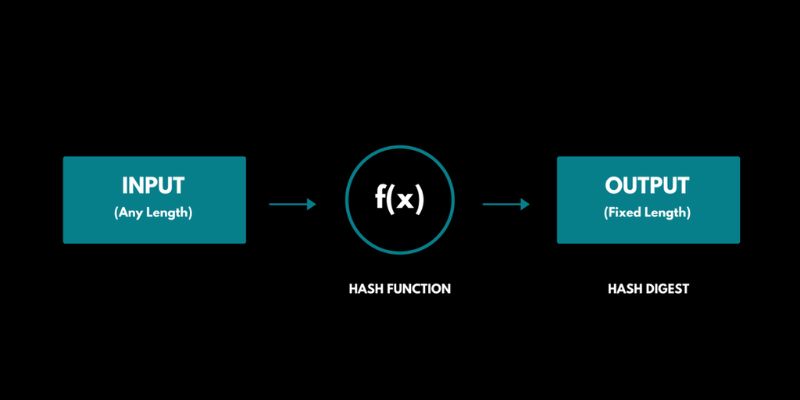Dive right in as I break down what is hashing in cryptocurrency? Imagine it’s a digital fingerprint for your crypto; unique, vital, irreplaceable. It’s the invisible armor that guards every bitcoin in your digital wallet from thieves and clones. We’ll kick off with hashing basics, making sure you get the full picture without the tech headache. Then, we’ll check out why hashing is the iron spine in crypto’s secure framework. Understand this, and you’ll be miles ahead in mastering your crypto game. From mining muscles to blockchain brains, hashing is the silent hero in the cryptocurrency saga, ensuring your digital wealth is safe and sound. Let’s unwrap this mystery together!
Understanding the Basics of Cryptocurrency Hashing
Exploring Hash Function Crypto
When it comes to keeping your digital money safe, we talk a lot about hash. Think of a hash like a secret code. But not just any code – one that helps protect your crypto coins. Hash function crypto is a special method that turns all kinds of info into a unique code. This code, or hash, keeps your payments and money secure.
Every time you do something in crypto, a hash function gets to work. It takes your info and scrambles it into a jumble of numbers and letters. This mix can be big or small, but either way, no one can guess it. This means your crypto dealings stay just between you and the person you’re dealing with.
So, how does it work? Let’s say you have a word like “apple.” The hash function takes “apple” and might turn it into something like “X3Y7B2.” Even if you try “apple” again, you get “X3Y7B2” once more – it’s always the same. But if you try “apples,” even that small change gives you a totally different jumble. That’s how we know it’s super safe.
Defining Hash Values in Digital Currency
Now, what’s a hash value? It’s that unique jumble I just talked about. Hash values in digital currency are important. They make sure every crypto coin is one of a kind and never mixed up with others. It’s like giving every single coin its own fingerprints. No two are the same, which helps stop folks from making fake ones.
A hash value also helps keep a record of all the deals you make. Every time coins move from one person to another, it’s like the hash takes a snapshot and adds it to a photo album. This photo album is our blockchain – a big book of every deal ever made.
Every time a new deal happens, miners use their computers to check the deals using hash values. These miners help out by making sure every hash checks out. This keeps everything fair and safe, and in return, they might get some new coins for their hard work.
In a nutshell, hash functions turn info into a unique code that protects your crypto. The hash value proves everything is legit. It’s like a stamp that says, “Yes, this is for real!” Understanding how hashing keeps your digital riches safe can make you feel good about using crypto. Remember, in our vast digital world, these unique codes are the guardians of your digital wallet.
The Role of Hash Functions in Cryptocurrency Security
Ensuring Collision Resistance and Pre-Image Resistance
When you trade with crypto, you trust the system. It all works because of something called hashing. It’s simple yet smart. Hashing turns your data into unique codes. Think of it like making a special smoothie. No matter what fruits you put in, you always get a unique taste that can’t be copied.
So here’s a thing – hash functions must fight off two big issues to keep your digital cash safe: collision resistance and pre-image resistance. Collision resistance means no two different transactions will ever create the same hash. It’s like no two people having the same fingerprint. Pre-image resistance means you can’t work backwards from the hash to find the original data. It keeps your details secret.
The Significance of Secure Hash Algorithm SHA-256 in Bitcoin
Bitcoin, the big boss of cryptocurrency, uses a special hash function called SHA-256. This stands for Secure Hash Algorithm 256-bit. In simple words, it scrambles data into a super long code of numbers and letters. We’re talking about a code so unique; it’s like finding a single grain of sand at the beach.
SHA-256 is popular in Bitcoin because it’s super strong. It takes a lot of work to make a Bitcoin hash, like trying to solve a tough puzzle. Only once the puzzle is solved do the miners earn their coin. This process is really important; it’s called “proof of work.” It’s like proving you did your homework to get a gold star.
Understanding SHA-256 helps us see why Bitcoin stays safe. With so much power behind every hash, it’s like having the best locks on your digital money. In the world of crypto, SHA-256 keeps your wealth a step away from the bad guys. That’s why when it comes to Bitcoin, we trust the tech to keep our digital gold safe and sound.
Mining and Hashing: The Backbone of Cryptocurrency Integrity
Deciphering the Correlation Between Mining and Hashing
Ever wondered how Bitcoin stays safe? It’s thanks to mining and hashing. They’re like Batman and Robin in the crypto world. They work together to keep your digital wealth secure.
So, what’s mining? Think of it as a game where players solve tough math puzzles. These players are miners. When a miner solves the puzzle, they get to add a ‘block’ of transactions to the Bitcoin chain.
But here’s where hashing steps in. It’s a way to turn info like transactions into a unique code. This code, or hash, is like a fingerprint. Every transaction block gets its own hash.
Let’s break it down. When a miner adds a block, they also include the hash from the last block. This links the blocks in a chain. Bingo! That’s the blockchain.
This link-up is the heart of cryptocurrency safety. If a hacker tries to mess with one block, the hash fingerprints change. The whole chain sees the change. The bad block gets tossed out.
Remember this—mining adds blocks, and hashing secures them. Together, they keep Bitcoin safe. Like two peas in a pod.
Hash Rate Meaning and Its Impact on Network Difficulty
Next, let’s talk about hash rate. It’s like a speedometer for mining. It measures how fast a miner can hash. More speed means more chances to solve the puzzle and win the game.
Imagine all miners racing to solve the puzzle first. The combined speed of all their computers is the network hash rate. A high hash rate means tough competition. So the Bitcoin network makes the puzzles harder. This is network difficulty for you.
Why does it matter? Well, the higher the network’s hashing speed, the more secure Bitcoin is. Fast hashing keeps bitcoin safe from attacks.
But there’s a catch. A high hash rate could mean more energy use. This energy talk is big these days. So, the race is on to make mining faster but with less power.
Now, when you hear about hash rate and difficulty, you’ll know. They make sure mining stays just tough enough. Tough enough to seal the deal on security.
So every time a miner hashes away and the network gets tougher, it’s all for a reason. It’s to guard your digital riches like treasure. A never-ending cycle that keeps our crypto strong, safe, and sound.
This buddy-system of mining and hashing isn’t just smart. It’s the wall that stands between our crypto and the bad guys. And as we work our way through more puzzles, we’re building a digital empire that stands tall on the power of hashes.
Advanced Hashing Concepts in Blockchain Technology
The Functionality of Hash Pointers and Merkle Trees
Ever peeked inside a blockchain? It’s like a super-smart filing system, storing records called blocks. Each block holds a bunch of transactions, like a page in a ledger. But here’s the really cool part – each block has a hash pointer. Think of it as a secret code. This code not only hides what’s inside but also points to the previous block. It’s like every page saying “Hey, the last page was this one, and it looked like this!” That’s super important because it means if someone messes with a page, we’ll know. Because then the code won’t match.
That’s not all, though. Bigger blockchains can’t just rely on these codes. They also use something called a Merkle tree. Imagine a tree where every leaf is a transaction. All these leaves then pair up, and each pair’s codes are mixed to make a new one, like a mini-summary. This mixing goes up the tree until there’s just one big code for the whole thing. It’s a brilliant shortcut. Instead of checking every single page, you just need to check the big code. If it matches, the whole tree is good.
Cryptographic Nonce and Double Hashing Techniques
Moving on to something called a cryptographic nonce. Now, it sounds weird, but nonce just means a number we use once. When miners try to add a new block, they have to find a special nonce. This number is gold because it makes the block’s code fit just right – like finding the missing piece in a puzzle. But they have to guess a zillion times, and it’s a race to find it first. That’s where the mining and hashing correlation kicks into overdrive.
Double hashing is one more trick up the blockchain’s sleeve. Think of it as double-wrapping a secret message. The first layer of wrapping is like any code, but then we wrap it again with another layer! Why? It’s like having two locks on your door instead of one. It’s extra security to make sure no one can break in. Bitcoin loves this method, using SHA-256 twice – that’s why it’s super secure.
In the crypto world, these advanced hash ideas keep our digital wealth safe. From hash pointers keeping an unbreakable chain to Merkle trees making checks fast, all the way to nonces and double hashing fighting to outsmart sneaky hackers, they’re the guardians of our digital treasure chests. And as we sail the high seas of the internet, it’s darn comforting to know our loot is locked up tight with the smartest security out there.
In this post, we’ve explored the nuts and bolts of crypto hashing, right from the basics to the high-level stuff. We dug into how hash functions work and why hash values matter so much in the world of digital cash. We saw that hashing is key to keeping cryptocurrencies safe, preventing mix-ups, and stopping hacks before they happen—thanks to the super strong SHA-256 and all that heavy-duty collision and pre-image resistance.
Then, we talked about mining. It’s not just about making new coins; it’s about the whole system’s honesty. The hash rate isn’t just a number; it’s a heartbeat that shows how tough the network is.
Lastly, we hit some advanced topics. Hash pointers and Merkle trees might sound like sci-fi, but they’re real tools making the blockchain tick. Add in the clever tricks with nonces and double hashing, and you’ve got a tech powerhouse.
So, there you have it. Hashing isn’t just techie talk; it’s the cornerstone of crypto integrity. It’s super clear that without hashing, there’d be no Bitcoin, no blockchain—no nothing. It’s pretty awesome when you think about it! Keep that in mind next time you hear about crypto; it all starts with a solid hash.
Q&A :
What Is Hashing in the Context of Cryptocurrencies?
Hashing serves as a foundational element in the world of cryptocurrencies, providing a secure and reliable means of processing information. Hashing is a procedure that converts input data of any size into a fixed-size string of characters, which typically appears as a random sequence of letters and numbers. In the context of cryptocurrencies like Bitcoin, hashing is crucial for the security and integrity of the blockchain. It’s the process that underlies mining, transaction processing, and blockchain maintenance.
How Does Hashing Ensure Security in Cryptocurrency Transactions?
Cryptocurrency transactions are secure because of hashing’s unique properties. Each transaction generates a hash, a one-way, irreversible cryptographic function that turns data into a distinctive hash value. If the information is altered even slightly, a different hash would be produced. This feature is pivotal for the security of blockchain as each block contains the hash of its predecessor, creating an unbreakable chain of blocks that’s virtually immune to tampering without detection.
What Hashing Algorithms Are Common in Cryptocurrency?
Different cryptocurrencies employ various hashing algorithms, each designed to address specific security needs. Bitcoin, for example, uses the SHA-256 algorithm, renowned for its complexity and security. Ethereum originally used Ethash, designed to be ASIC-resistant, making it favorable for GPU mining. Other notable hashing algorithms include Scrypt, which is used by Litecoin, and X11, embraced by Dash. The choice of algorithm affects the speed and security of transactions within the cryptocurrency’s network.
Why Is Hashing Considered Effective for Cryptocurrency Mining?
Hashing is critical for cryptocurrency mining because it is used to validate transactions and add new blocks to the blockchain. Miners compete to solve complex mathematical puzzles using the hashing algorithm specific to the cryptocurrency they are mining. The first miner to find a hash that matches the correct criteria for the next block is rewarded with a set amount of cryptocurrency. Hashing ensures that the competition is fair and that each transaction is verified before being permanently inscribed onto the blockchain.
Can Hashing in Cryptocurrency Be Reversed?
Cryptographic hashes, by design, are one-way functions. This means that once information has been encrypted into a hash code, it cannot be easily reversed to reveal the original input data. This characteristic is one of the key aspects that affords security within cryptocurrencies—as it prevents the possibility of reverse-engineering of hash values to manipulate transaction data or blockchain integrity. The computational effort required to invert hashes is intentionally prohibitive, ensuring the safety of the cryptocurrency network.





